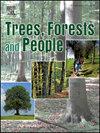Quantifying winter forage resources for reindeer: Developing a method to estimate ground lichen cover and biomass at a local scale
IF 2.7
Q1 FORESTRY
引用次数: 0
Abstract
Boreal forests serve as the primary winter range for reindeer (Rangifer tarandus) in Sweden, where ground lichens constitute the main food source. Lichen-rich forests have declined drastically, and modern forest practices, along with other land uses, impact both the quantity and availability of lichen. The resulting reduction in lichen has serious consequences for reindeer and Sami reindeer husbandry. Consequently, robust methods for mapping and measuring lichen are highly sought after.
We developed and implemented a multistep method for objectively estimating lichen cover and biomass. We collected data at three study sites in lichen-rich pine forests in northern Sweden during July–August 2021. First, we collected data on NDVI and tree cover using a drone. These data informed a spatially balanced sampling approach to provide a distribution of plots for a representative field sample. Following this, we collected field data on lichen cover and height in these plots. In addition, we compared methods for assessing lichen cover in the field and found that visual estimates resulted in lower values than a point-intercept method. We recommend the point-intercept method for its objectivity and consistency between observers. By combining data from a literature review and fitting a linear regression on lichen volume (dm³ m⁻²) and biomass (kg dry weight m⁻²) through the origin, we determined a slope of 0.0148 for estimating biomass from volume measures. Using this relationship with field data on lichen cover and height, we obtained statistically unbiased estimates of lichen cover and biomass. This approach reduces the time required compared to destructive methods involving lichen collection and weighing.
While our method provides lichen cover and biomass estimates, we also demonstrate how these biomass estimates can be linked to the number of reindeer grazing days an area can sustain each year, enhancing the usefulness of the results. Our estimates will be valuable in planning and management of reindeer husbandry, as well as for quantifying the loss of the ground lichen resource in forestry, energy and mining industries.
量化驯鹿冬季饲料资源:开发一种估算当地地衣覆盖和生物量的方法
在瑞典,北方森林是驯鹿(Rangifer tarandus)冬季的主要栖息地,地衣是驯鹿的主要食物来源。富含地衣的森林急剧减少,现代森林实践以及其他土地利用影响了地衣的数量和可用性。由此导致的地衣减少对驯鹿和萨米驯鹿畜牧业造成严重后果。因此,测绘和测量地衣的可靠方法受到高度追捧。我们开发并实现了一个多步骤的方法来客观地估计地衣覆盖和生物量。我们于2021年7月至8月在瑞典北部地衣丰富的松林的三个研究地点收集了数据。首先,我们使用无人机收集NDVI和树木覆盖的数据。这些数据为空间平衡采样方法提供了信息,以提供具有代表性的现场样本的地块分布。随后,我们收集了这些样地的地衣覆盖和地衣高度的野外数据。此外,我们比较了评估野外地衣覆盖的方法,发现视觉估计值低于点截法。我们推荐点截法,因为它的客观性和观察者之间的一致性。通过结合文献回顾的数据,并拟合苔藓体积(dm³⁻²)和生物量(kg干重m⁻²)的线性回归,我们确定了一个0.0148的斜率,用于从体积测量中估计生物量。利用这种关系与地衣覆盖和高度的野外数据,我们获得了地衣覆盖和生物量的统计无偏估计值。与涉及地衣收集和称重的破坏性方法相比,这种方法减少了所需的时间。虽然我们的方法提供了地衣覆盖和生物量估计,但我们也证明了这些生物量估计如何与一个地区每年可以维持的驯鹿放牧天数联系起来,从而提高了结果的实用性。我们的估算对驯鹿畜牧业的规划和管理,以及对林业、能源和采矿业的地衣资源损失进行量化具有重要价值。
本文章由计算机程序翻译,如有差异,请以英文原文为准。
求助全文
约1分钟内获得全文
求助全文
来源期刊

Trees, Forests and People
Economics, Econometrics and Finance-Economics, Econometrics and Finance (miscellaneous)
CiteScore
4.30
自引率
7.40%
发文量
172
审稿时长
56 days
 求助内容:
求助内容: 应助结果提醒方式:
应助结果提醒方式:


